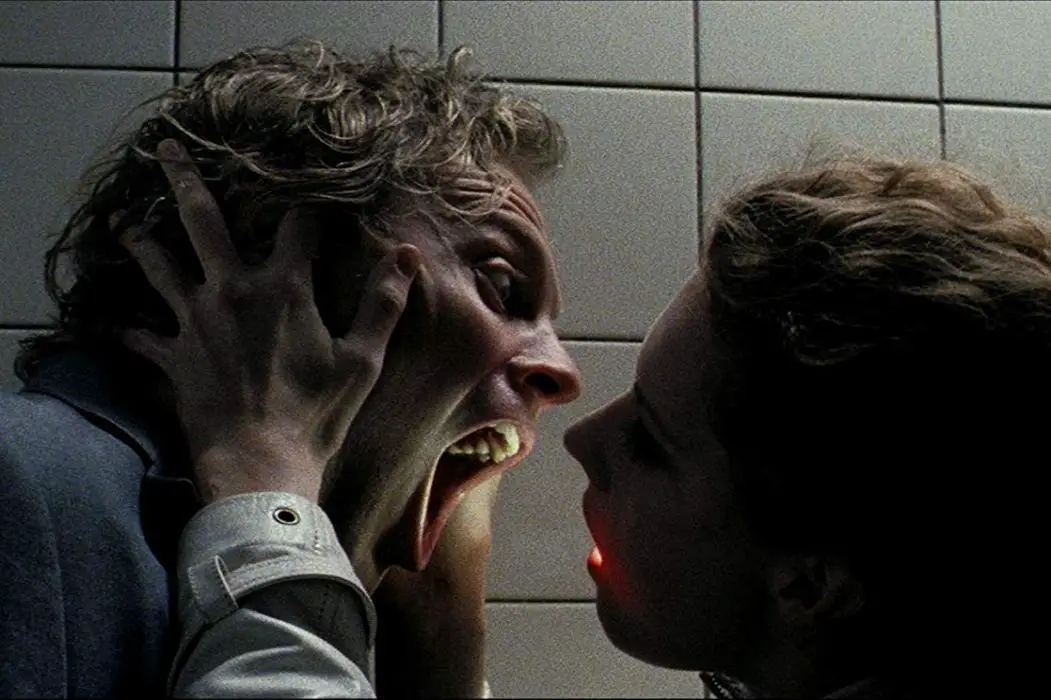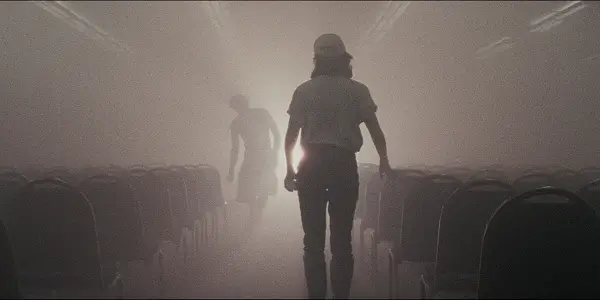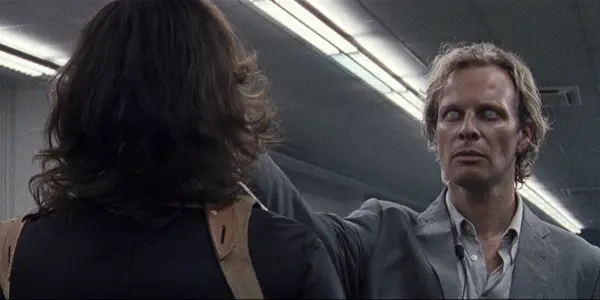LUZ: A Giallo Throwback That Thrills

Lee Jutton has directed short films starring a killer toaster,…
Luz, the debut feature from German filmmaker Tilman Singer, boasts one of the most subtly sinister opening sequences I have seen on screen in some time. One night, a young cab driver (the titular Luz, played by Luana Velis), shuffles into the reception area of a garishly lit and shockingly run-down police station. The retro-synth score by Simon Waskow – deliciously reminiscent of Goblin’s classic work for Suspiria – hums, buzzes, and swells as Luz slowly obtains a drink from a vending machine. The mundane sounds of the clanging of her change and the crisp click of the can opening are rendered shockingly intimidating when layered over the musical score in the silence of the police station.
The entire scene proceeds without a single cut or word of dialogue, anticipation slowly building, until Luz finally approaches the reception desk. “Is this how you want to live your life? Is this seriously what you want?” she growls in Spanish. Boom – the title card, with huge crackling red letters imposed on a black background, smashes onto the screen. From here, Luz spirals outward and downward into a bizarre story of demonic possession and seduction that should thrill fans of Dario Argento and other Giallo masters.
The Haunting
Away from the police station, in an almost-empty bar that appears to be situated in a concrete hangar of some kind, the psychiatrist Dr. Rossini (Jan Bluthardt) is enjoying a drink when he is approached by a mysterious femme fatale named Nora (Julia Riedler). Over a series of colorful c*cktails that grow increasingly (and hilariously) more complicated to mix and drink, Nora regales Rossini with the torrid tale of her old schoolmate Luz. While the girls were at a Catholic boarding school, Luz attempted to use her roommate as a vessel in an occult ritual. In doing so, Luz loosed a demonic spirit onto the world – and now, that spirit is obsessed with finding Luz again.

Meanwhile, Luz is taken to meet with police detective Bertillon (Nadja Stübiger) and her partner Olarte (Johannes Benecke), who also translates Luz’s words from Spanish to German as needed. Luz has jumped out of her cab, but the detectives cannot figure out why. They call in Rossini, who hypnotizes Luz and gets her to reenact her entire evening up until she abandoned her cab. But Rossini is not the same man he once was; his encounter with Nora has altered him in drastic ways that are only gradually revealed to Bertillon and Olarte – and by the time they figure out what’s going on, it might be too late to save Luz from the demon who loves her.
Scary Stories to Tell in the Dark
Luz is a love letter to vintage horror in both style and substance, from Waskow’s eerie, synth-soaked score, to Paul Faltz’s flat 16mm cinematography (complete with the natural crackles and flaws of the filmstrip), to the story’s roots in an all-girls’ boarding school and the uniquely frightening things that can happen within those walls. Based on the retro touches to the production design and the fact that Rossini carries a pager instead of a cell phone, Luz appears to take place at some undefined moment in the past; this lack of certainty only adds to the film’s disorienting atmosphere. Because the film takes place almost entirely indoors, it also has an inherently claustrophobic quality – fitting for a film that revolves around a young woman’s inability to escape the (metaphorical and literal!) demons of her past.

The film’s performances are all solid, but to be quite honest, the acting takes a backseat to the overall visual splendor of the production. Every last detail onscreen – from the rows of empty chairs in the police conference room that bear an uncanny resemblance to the pews of a church, to the silly swizzle sticks that adorn Rossini and Nora’s drinks and add a disconcertingly humorous touch to Nora’s unsettling story – feels uniquely fitting to the tale being spun by Singer and company and adds an authenticity to this supernatural story that only makes it feel scarier. And despite being obviously low-budget, Luz makes the most of some clever practical effects, aided by nimble editing from Singer and Fabian Podeszwa.
The lengthy sequence in which Luz is hypnotized constitutes the bulk of the 70-minute film and layers sound and image to masterful effect. Singer cuts back and forth between the police station conference room in which Luz sits and the inside of her cab as the events she is reliving first occurred; the sounds of the past – the hum of the music on the radio, the honks of other cars on the road – invade the world of the present and make the audience increasingly unable to determine what is happening when. Is it reality, memory or a demon-induced hallucination? Either way, the result is phantasmagoric perfection.

Luz: Conclusion
While Luz has all of the trappings of a horror film of yesteryear, it is clear that Tilman Singer is an exciting new filmmaker to watch. Every frame of his debut feature will enrapture you and every sound will make you shudder with frightened anticipation of what lies ahead.
What do you think? Does Luz sound like a satisfying new entry in the horror genre? Share your thoughts in the comments below.
Watch Luz
Does content like this matter to you?
Become a Member and support film journalism. Unlock access to all of Film Inquiry`s great articles. Join a community of like-minded readers who are passionate about cinema - get access to our private members Network, give back to independent filmmakers, and more.
Lee Jutton has directed short films starring a killer toaster, a killer Christmas tree, and a not-killer leopard. Her writing has appeared in publications such as Film School Rejects, Bitch: A Feminist Response to Pop Culture, Bitch Flicks, TV Fanatic, and Just Press Play. When not watching, making, or writing about films, she can usually be found on Twitter obsessing over soccer, BTS, and her cat.













